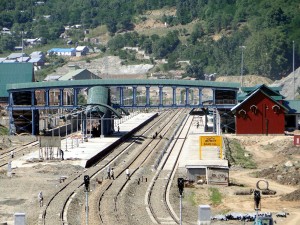Excelsior Correspondent

NEW DELHI, June 7: The Banihal-Qazigund section of Udhampur-Srinagar-Baramullah rail link is likely to be commissioned by the end of this month after the statutory inspection by Commissioner of Railway Safety (CRS) for running passenger trains.
Trial run on this section was successfully done on December 28 last year, and since then ballast trains are running on regular basis.
“The inspection of CRS is scheduled for the next week and we are expecting the line to open in the last of this month,” a senior Northern Railway official said.
The opening of Banihal-Qazigund railway section will connect J&K with the Valley. This section will have two main railway stations – Banihal in Jammu division and Qazigund in Kashmir division. In addition to these stations, a halt station is also being provided at Hillar village in Anantnag district for the convenience of local public.
Currently, problems are being faced by passengers travelling between Banihal and Qazigund due to closure of Jawahar Tunnel in winter months due to heavy snowfall.
Last winter, one-way vehicular movement was resorted to between Jammu and Srinagar on national highway. There were sudden closures for almost four months from December 2012 to March this year due to heavy snowfall and slippery conditions.
“All these problems will be reduced to a large extent by running of train services between Banihal-Qazigund, the official said, adding that “it will be a cheaper, faster and dependable mode of transport for the people.”
With the operation of the line, the distance between Banihal and Qazigund will be reduced from 35 km to 17 kms. The 18 km-long Banihal-Qazigund section passing through a 11 km long tunnel has been constructed with a total expenditure of Rs 1,691 crore.
Known as Pir Panjal tunnel, it is the longest transportation tunnel in India and third longest in Asia. The tunnel has been constructed at an estimated cost of Rs 1,300 crore and taken almost seven years to complete.
The tunnel has been constructed using New Austrian Tunnelling Method, which was for the first time used on such largescale in India.
This method optimises the tunnel design by mobilising the inherent ground strength in adopting a curved section, providing primary support system immediately after excavation and monitoring the ground behaviour while permitting it to develop its inherent strength.
A three-meter wide road has been provided inside the tunnel for maintenance, emergency rescue and relief operations. The tunnel has been made water-proof by providing continuous PVC membrane between primary and secondary lining.
The tunnel has been equipped with the state-of-the-art air quality monitoring system, ventilation system, communication system, fire fighting system and emergency rescue system in case of emergency.

